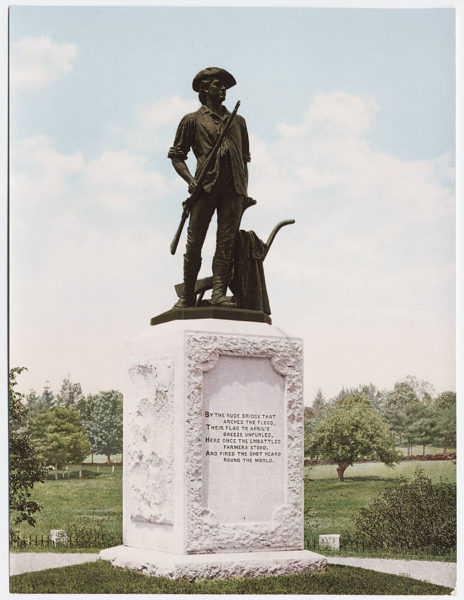 A coal fire also burns much hotter, and with more acidic fumes, than a wood fire. Pots that worked well enough for wood — typically brass, either thin beaten-brass or thicker cast-brass — degrade rapidly over coal, and people increasingly switched to iron, which takes longer to heat but lasts much better. At the beginning of the shift to coal, the only option for pots was wrought iron — nearly pure elemental iron, wrought (archaic past tense of “worked”, as in “what hath God wrought”) with hammer and anvil, a labor-intensive process. But since the advent of the blast furnace in the late fifteenth century, there was a better, cheaper material available: cast iron.1 It was already being used for firebacks, rollers for crushing malt, and so forth, but English foundries were substantially behind those of the continent when it came to casting techniques in brass and were entirely unprepared to make iron pots with any sort of efficiency. The innovator here was Abraham Darby, who in 1707 filed a patent for a dramatically improved method of casting metal for pots — and also, incidentally, used a coal-fired blast furnace to smelt the iron. This turned out to be the key: a charcoal-fueled blast furnace, which is what people had been using up to then, makes white cast iron, a metal too brittle to be cast into nicely curved shapes like a pot. Smelting with coal produces gray cast iron, which includes silicon in the metal’s structure and works much better for casting complicated shapes like, say, parts for a steam engine. Coal-smelted iron would be the key material of the Industrial Revolution, but the economic incentive for its original development was the early modern market for pots, kettles, and grates suitable for cooking over the heat and fumes of a coal fire.2
A coal fire also burns much hotter, and with more acidic fumes, than a wood fire. Pots that worked well enough for wood — typically brass, either thin beaten-brass or thicker cast-brass — degrade rapidly over coal, and people increasingly switched to iron, which takes longer to heat but lasts much better. At the beginning of the shift to coal, the only option for pots was wrought iron — nearly pure elemental iron, wrought (archaic past tense of “worked”, as in “what hath God wrought”) with hammer and anvil, a labor-intensive process. But since the advent of the blast furnace in the late fifteenth century, there was a better, cheaper material available: cast iron.1 It was already being used for firebacks, rollers for crushing malt, and so forth, but English foundries were substantially behind those of the continent when it came to casting techniques in brass and were entirely unprepared to make iron pots with any sort of efficiency. The innovator here was Abraham Darby, who in 1707 filed a patent for a dramatically improved method of casting metal for pots — and also, incidentally, used a coal-fired blast furnace to smelt the iron. This turned out to be the key: a charcoal-fueled blast furnace, which is what people had been using up to then, makes white cast iron, a metal too brittle to be cast into nicely curved shapes like a pot. Smelting with coal produces gray cast iron, which includes silicon in the metal’s structure and works much better for casting complicated shapes like, say, parts for a steam engine. Coal-smelted iron would be the key material of the Industrial Revolution, but the economic incentive for its original development was the early modern market for pots, kettles, and grates suitable for cooking over the heat and fumes of a coal fire.2
In Ruth Goodman’s telling, though, the greatest difference between coal and wood fires is the smoke. Smoke isn’t something we think much about these days: on the rare occasions I’m around a fire at all, I’m either outdoors (where the smoke dissipates rapidly except for a pleasant lingering aroma on my jacket) or in front of a fireplace with a good chimney that draws the smoke up and out of the house. However, a chimney also draws about 70% of the fire’s heat — not a problem if you’re in a centrally-heated modern home and enjoying the fire for ✨ambience✨, but a serious issue if it’s the main thing between your family and the Little Ice Age outdoors. Accordingly, premodern English homes didn’t have chimneys: the fire sat in a central hearth in the middle of the room, radiating heat in all directions, and the smoke slowly dissipated out of the unglazed windows and through the thatch of the roof. Goodman describes practical considerations of living with woodsmoke that never occurred to me:
In the relatively still milieu of an interior space, wood smoke creates a distinct and visible horizon, below which the air is fairly clear and above which asphyxiation is a real possibility. The height of this horizon line is critical to living without a chimney. The exact dynamics vary from building to building and from hour to hour as the weather outside changes. Winds can cause cross-draughts that stir things up; doors and shutters opening and closing can buffet smoke in various directions. … From my experiences managing fires in a multitude of buildings in many different weather conditions, I can attest to the annoyance of a small change in the angle of a propped-open door, the opening of a shutter or the shifting of a piece of furniture that you had placed just so to quiet the air. And as for people standing in doorways, don’t get me started.
One obvious adaptation was to live life low to the ground. On a warm day the smoke horizon might be relatively high, but on a cold damp one (of which, you may be aware, England has quite a lot) smoke hovers low enough that even sitting in a tall chair might well put your head right up into it. Far better to sit on a low stool, or, better yet, a nice soft insulating layer of rushes on the floor.
Chimneys did exist before the transition to coal, but given the cost of masonry and the additional fuel expenses, they were typically found only in the very wealthiest homes. Everyone else lived with a central hearth and if they could afford it added smoke management systems to their homes piecemeal. Among the available solutions were the reredos (a short half-height wall against which the fire was built and which would counteract drafts from doorways), the smoke hood (rather like our modern cooktop vent hood but without the fan, allowing some of the smoke to rise out of the living space without creating a draw on the heat), or the smoke bay (a method of constructing an upstairs room over only part of the downstairs that still allowed smoke to rise and dissipate through the roof). Wood smoke management was mostly a question of avoiding too great a concentration in places you wanted your face to be. The switch to coal changed this, though, because coal smoke is frankly foul stuff. It hangs lower than wood smoke, in part because it cools faster, and it’s full of sulfur compounds that combine with the water in your eyes and lungs to create a mild sulfuric acid; when your eyes water from the irritation, the stinging only gets worse. Burning coal in an unvented central hearth would have been painful and choking. If you already had one of the interim smoke management techniques of the wood-burning period — especially the smoke hood — you would have found adopting coal more appealing, but really, if you burned coal, you wanted a chimney. You probably already wanted a chimney, though; they had been a status symbol for centuries.
And indeed, chimneys went up all over London; their main disadvantage, aside from the cost of a major home renovation, had been the way they drew away the heat along with the smoke, but a coal fire’s greater energy output made that less of an issue. The other downside of the chimney’s draw, though, is the draft it creates at ground level. Again, this isn’t terribly noticeable today because most of us don’t spend a lot of time sitting in front of the fireplace (or indeed, sitting on the floor at all, unless we have small children), but pay attention next time you’re by an indoor wood fire and you will notice a flow of cold air for the first inch or two off the ground. All of a sudden, instead of putting your mattress directly on the drafty floor, you wanted a bedstead to lift it up — and a nice tall chair to sit on, and a table to pull your chair up to as well. There were further practical differences, too: because a chimney has to be built into a wall, it can’t heat as large an area as a central fire. This incentivized smaller rooms, which were further enabled by the fact that a coal fire can burn much longer without tending than a wood fire. A gentleman doesn’t have much use for small study where he can retreat to be alone with his books and papers if a servant is popping in every ten minutes to stir up the fire, but if the coals in the grate will burn for an hour or two untended he can have some real privacy. The premodern wood-burning home was a large open space where many members of the household, both masters and servants, went about their daily tasks; the coal-burning home gradually became a collection of smaller, furniture-filled spaces that individuals or small groups used for specific purposes. Nowhere is this shift more evident than in the word “hall”, which transitions from referring to something like Heorot to being a mere corridor between rooms.
Jane Psmith, “REVIEW: The Domestic Revolution by Ruth Goodman”, Mr. and Mrs. Psmith’s Bookshelf, 2023-05-22.
1. Brief ferrous metallurgy digression: aside from the rare, relatively pure iron found in meteors, all iron found in nature is in the form of ores like haematite, where the iron bound up with oxygen and other impurities like silicon and phosphorus (“slag”). Getting the iron out of the ore requires adding carbon (for the oxygen to bond with) and heat (to fuel the chemical reaction): Fe2O3 + C + slag → Fe + CO2 + slag. Before the adoption of the blast furnace, European iron came from bloomeries: basically a chimney full of fuel hot enough to cause a reduction reaction when ore is added to the top, removing the oxygen from the ore but leaving behind a mass of mixed iron and slag called a bloom. The bloom would then be heated and beaten and heated and beaten — the hot metal sticks together while the slag crumbles and breaks off — to leave behind a lump of nearly pure iron. (If you managed the temperature of your bloomery just right you could incorporate some of the carbon into the iron itself, producing steel, but this was difficult to manage and carbon was usually added to the iron afterwards to make things like armor and swords.) In a blast furnace, by contrast, the fuel and ore were mixed together and powerful blasts of air were forced through as the material moved down the furnace and the molten iron dripped out the bottom. From there it could be poured directly into molds and cast into the desired shape. This is obviously much faster and easier! But cast iron has much more carbon, which makes it very hard, lowers its melting point, and leaves it extremely brittle — you would never want a cast iron sword. (The behavior of various ferrous metals is determined by the way the non-metal atoms, especially carbon, interrupt the crystal structure of the iron. Wrought iron has less than .08% carbon by weight, modern “low carbon” steel between .05% and .3%, “high carbon” steel about 1.7%, and cast iron more than 3%.)
2. The sales of those cooking implements went on to provide the capital for further innovation: Darby’s son and grandson, two more Abrahams, also played important roles in the Industrial Revolution.








